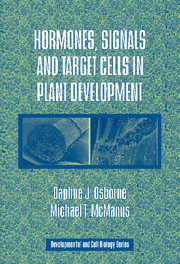Book contents
- Frontmatter
- Contents
- Preface
- 1 Introduction
- 2 Hormones and Signals: Identification and Description of Signalling Molecules
- 3 Cell-to-Cell Signalling: Short and Long Distance
- 4 Population Diversity of Cell Types and Target Identification in Higher Plants
- 5 Flexibility of Cell Types and the Target Cell Status
- 6 Terminally Committed Cell Types and the Target Status
- 7 The Mechanisms of Target Cell Perception and Response to Specific Signals
- 8 Hormone Action and the Relief of Repression
- 9 The Phenomenon of Hormonal Cross-Talk
- References
- Index
6 - Terminally Committed Cell Types and the Target Status
Published online by Cambridge University Press: 06 August 2009
- Frontmatter
- Contents
- Preface
- 1 Introduction
- 2 Hormones and Signals: Identification and Description of Signalling Molecules
- 3 Cell-to-Cell Signalling: Short and Long Distance
- 4 Population Diversity of Cell Types and Target Identification in Higher Plants
- 5 Flexibility of Cell Types and the Target Cell Status
- 6 Terminally Committed Cell Types and the Target Status
- 7 The Mechanisms of Target Cell Perception and Response to Specific Signals
- 8 Hormone Action and the Relief of Repression
- 9 The Phenomenon of Hormonal Cross-Talk
- References
- Index
Summary
Cells that we see as permanently committed offer us the opportunity to follow their performance in both excised pieces of plant tissue as well as in planta. With a number of these it has been possible to establish with relative certainty the nature of their target status and the inputs of signals and signalling molecules that they can both perceive and respond to in predictable ways.
Also, it has been possible to follow associations with neighbour cells that influence the pathway to the committed cell state and to deduce certain of the cross-talk and physical communication that leads to a final differentiated condition. Two types of commitment have been considered. The first type is one in which the committed cells remain alive in the body of the plant and their function can therefore be called into operation by the perception of specific signals evoking a one time only response (as is the case with abscission or aleurone cells) or by the differentiation of a response mechanism that can be activated many times without loss of function (as in statocytes and stomata). The second terminally committed cell type to be considered is one that dies in situ amongst its living cell neighbours in the progress of the commitment, but then forms an essential component of the plant's structural architecture and overall function.
- Type
- Chapter
- Information
- Hormones, Signals and Target Cells in Plant Development , pp. 117 - 145Publisher: Cambridge University PressPrint publication year: 2005



